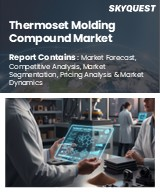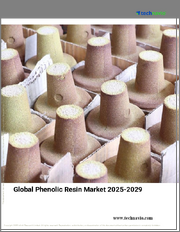
|
시장보고서
상품코드
1635965
페놀 수지 시장 : 제품 유형별, 용도별, 최종 이용 산업별, 지역별(2025-2033년)Phenolic Resins Market by Product Type, Application, End Use Industry, and Region 2025-2033 |
||||||
페놀 수지 시장의 세계 시장 규모는 2024년 162억 달러에 달했습니다. 향후 IMARC Group은 2033년까지 시장 규모가 240억 달러에 달할 것으로 예상하며, 2025-2033년 연평균 성장률(CAGR)은 4.24%에 달할 것으로 전망하고 있습니다. 시장 성장의 원동력은 높은 열 안정성과 기계적 강도로 인해 건설 산업과 자동차 산업에서 수요가 증가하고 있다는 점입니다. 또한 목재용 접착제, 라미네이트, 성형 컴파운드 등에도 폭넓게 사용되고 있는 점도 시장 성장을 견인하고 있습니다. 기술 발전과 전기 및 전자 분야에서의 사용 증가는 시장 성장을 더욱 촉진하고 있습니다. 지속가능하고 친환경적인 재료의 사용을 촉진하는 환경 규제 또한 페놀 수지의 수요에 기여하고 있습니다.
페놀 수지는 페놀과 포름알데히드의 중축합으로 제조된 합성 고분자를 말합니다. 고압 라미네이트, 브레이크 라이닝, 단열재, 주조 코어, 코팅, 접착제, 연마재 제조에 널리 사용됩니다. 또한 페놀 수지는 인쇄회로기판(PCB) 및 마찰재 제조에도 필수적입니다. 뛰어난 열 안정성, 높은 기계적 강도, 우수한 내화학성, 우수한 난연성을 나타냅니다. 페놀 수지는 우수한 치수 안정성, 내열성, 내전압성, 비용 효율적이며 유연하고 성형이 가능한 제품입니다.
여러 정부가 배출가스를 규제하고 환경 친화적인 제품을 장려하기 위해 엄격한 규제를 부과함에 따라 독성 및 배출 수준이 낮아 제품 수요가 촉진되고 있습니다. 또한, 항공우주 산업 및 해양 산업과 같은 다양한 분야에서 응용 분야를 확대하기 위해 페놀 수지 제조에 대한 광범위한 연구 개발(R&D) 활동이 시장 성장을 촉진하고 있습니다. 또한, 라미네이트, 코팅, 단열재 등의 용도로 제품이 널리 사용되고 있는 것도 시장 성장에 긍정적인 영향을 미치고 있습니다. 또한, 가구 산업에서 접착 및 라미네이트 가공에 대한 제품 채택이 확대되고 있는 것도 시장 성장에 기여하고 있습니다. 그 외, 급속한 산업화, 페놀 수지의 첨단 제조 공정 개발에 대한 투자 증가, 주조 산업에서의 제품 사용 증가 등이 시장 성장을 촉진할 것으로 예상됩니다.
페놀 수지 시장 동향/촉진요인:
자동차 산업의 괄목할만한 성장
세계 자동차 산업은 최근 몇 년 동안 강력한 성장세를 보이고 있습니다. 페놀 수지는 우수한 내열성, 높은 기계적 강도, 경량성으로 인해 브레이크 라이닝, 클러치 페이싱, 디스크 브레이크 패드 등 다양한 자동차 용도에 사용이 증가하고 있습니다. 이들은 자동차의 안전성 향상, 연비 향상, 종합 성능 향상에 크게 기여하고 있습니다. 또한, 에너지 절약과 이산화탄소 배출 감소로 전환하는 추세 속에서 페놀 수지와 같은 경량 소재에 대한 수요는 점점 더 중요해지고 있습니다. 가벼운 재료로 만든 자동차는 연료 소비를 줄이고 효율성을 높여 환경에 미치는 영향을 줄일 수 있습니다. 또한, 복잡한 부품의 제조를 용이하게 하고 자동차 제조업체에 설계 유연성을 제공하는 우수한 성형 능력으로 인해 자동차 산업에서 제품이 널리 채택되고 있는 것도 시장 성장을 뒷받침하고 있습니다.
건설 부문의 급속한 확장
도시화, 인구 증가, 인프라 투자 증가로 인해 주거 및 상업용 건설 산업은 전 세계적으로 크게 성장하고 있습니다. 페놀 수지는 내구성, 내화성, 내화학성이 뛰어나 다양한 건축자재에서 필수적인 역할을 하고 있습니다. 건축용 합판 및 파티클보드용 목재 접착제에 널리 사용되어 내수성을 높입니다. 또한, 그 단열 특성은 에너지 효율이 높은 구조물을 건설하는 데 중요한 단열 제품에 이상적입니다. 건축 규제 및 설계 고려사항에서 에너지 절약이 점점 더 중요해짐에 따라 페놀 수지를 사용한 단열 제품에 대한 수요가 급증하고 있습니다. 전 세계적으로 건설 부문이 확대되고 지속가능하고 에너지 효율적인 건축자재에 대한 관심이 높아짐에 따라 페놀 수지가 선택되는 재료가 되어 시장 성장에 박차를 가하고 있습니다.
전자 분야에서의 제품 사용 증가
세계 전자 산업은 기술 발전, 가전제품 수요 증가, 사물인터넷(IoT) 기기 채택 증가로 인해 급속한 성장을 경험하고 있습니다. 페놀 수지는 우수한 전기 절연 능력으로 인해 전자부품 제조에 널리 사용되고 있습니다. 이에 따라 사실상 모든 전자기기의 골격이 되는 인쇄회로기판(PCB) 제조에 필수적입니다. 페놀 수지는 열악한 사용 조건에서도 인쇄회로기판의 내구성과 신뢰성을 보장합니다. 또한, 페놀 수지의 내화성은 전자기기에서 매우 중요하며, 화재 관련 사고의 위험을 최소화합니다. 또한, 페놀 수지는 전자 인클로저 및 배전반 부품에도 사용되어 전기 절연을 제공하고 제품 수명을 향상시킵니다. 그 결과, 전자 산업의 급속한 성장과 페놀 수지에 대한 의존도가 페놀 수지 시장을 발전시키고 있습니다.
목차
제1장 서문
제2장 조사 범위와 조사 방법
- 조사 목적
- 이해관계자
- 데이터 소스
- 1차 정보
- 2차 정보
- 시장 추정
- 상향식 접근
- 하향식 접근
- 조사 방법
제3장 주요 요약
제4장 소개
- 개요
- 주요 업계 동향
제5장 세계의 페놀 수지 시장
- 시장 개요
- 시장 실적
- COVID-19의 영향
- 시장 예측
제6장 시장 내역 : 제품 유형별
- 노볼락
- 시장 동향
- 시장 예측
- 레졸
- 시장 동향
- 시장 예측
제7장 시장 내역 : 용도별
- 성형
- 시장 동향
- 시장 예측
- 접착제
- 시장 동향
- 시장 예측
- 절연
- 시장 동향
- 시장 예측
- 라미네이트
- 시장 동향
- 시장 예측
- 코팅
- 시장 동향
- 시장 예측
- 종이 함침
- 시장 동향
- 시장 예측
- 기타
- 시장 동향
- 시장 예측
제8장 시장 내역 : 최종 이용 산업별
- 자동차·운송
- 시장 동향
- 시장 예측
- 가전
- 시장 동향
- 시장 예측
- 건축·건설
- 시장 동향
- 시장 예측
- 석유 및 가스
- 시장 동향
- 시장 예측
- 가구
- 시장 동향
- 시장 예측
- 기타
- 시장 동향
- 시장 예측
제9장 시장 내역 : 지역별
- 북미
- 미국
- 캐나다
- 아시아태평양
- 중국
- 일본
- 인도
- 한국
- 호주
- 인도네시아
- 기타
- 유럽
- 독일
- 프랑스
- 영국
- 이탈리아
- 스페인
- 러시아
- 기타
- 라틴아메리카
- 브라질
- 멕시코
- 기타
- 중동 및 아프리카
제10장 촉진요인, 억제요인, 기회
- 개요
- 성장 촉진요인
- 성장 억제요인
- 기회
제11장 밸류체인 분석
제12장 Porter's Five Forces 분석
- 개요
- 구매자의 교섭력
- 공급 기업의 교섭력
- 경쟁 정도
- 신규 참여업체의 위협
- 대체품의 위협
제13장 가격 분석
제14장 경쟁 구도
- 시장 구조
- 주요 기업
- 주요 기업 개요
- Akrochem Corporation
- Allnex GMBH(PTT Global Chemical)
- Bakelite Synthetics
- Bostik Inc.(Arkema S.A.)
- DIC Corporation
- Hexion Inc.
- Kolon Industries Inc.
- Kraton Corporation(DL Chemical Co. Ltd.)
- Prefere Resins Holding GmbH
- Shandong Laiwu Runda New Material Co. Ltd.
- SI Group Inc.
- Sumitomo Bakelite Company Limited
The global phenolic resins market size reached USD 16.2 Billion in 2024. Looking forward, IMARC Group expects the market to reach USD 24.0 Billion by 2033, exhibiting a growth rate (CAGR) of 4.24% during 2025-2033. The market growth is driven by the increasing demand from the construction and automotive industries due to their high thermal stability and mechanical strength. Additionally, their extensive use in wood adhesives, laminates, and molding compounds drives the market toward growth. Technological advancements and rising applications in electrical and electronics sectors further boost the market growth. Environmental regulations promoting the use of sustainable and eco-friendly materials also contribute to the demand for phenolic resins.
Phenolic resins refer to synthetic polymers produced through the polycondensation of phenol with formaldehyde. They are widely used in producing high-pressure laminates, brake linings, insulation materials, foundry cores, coatings, adhesives, and abrasives. Additionally, phenolic resins are essential for manufacturing printed circuit boards (PCBs) and friction materials. They exhibit exceptional thermal stability, high mechanical strength, superb chemical resistance, and impressive fire resistance. Phenolic resins are cost-effective, flexible, and moldable products that provide excellent dimensional stability, heat and electricity resistance.
The imposition of strict regulations by several governments to control emissions and encourage environmentally friendly products is facilitating product demand due to its low toxicity and emission levels. Furthermore, extensive research and development (R&D) activities in the manufacturing of phenolic resins to expand their application across diverse sectors, such as the aerospace and marine industries, are boosting the market growth. Additionally, the widespread product utilization in applications, such as laminates, coatings, and insulation materials, is positively influencing the market growth. Moreover, the growing product adoption in the furniture industry for bonding and laminating processes is contributing to the market growth. Other factors, including rapid industrialization, increasing investment in developing advanced manufacturing processes for phenolic resins, and rising product utilization in the foundry industry, are anticipated to drive the market growth.
Phenolic Resins Market Trends/Drivers:
The significant growth in the automotive industry
The global automotive industry has witnessed robust growth over recent years. Phenolic resins, due to their superior heat resistance, high mechanical strength, and lightweight, are increasingly utilized for various automotive applications, such as brake linings, clutch facings, and disc brake pads. They significantly contribute to enhanced vehicle safety, increasing fuel efficiency, and enhancing overall performance. Additionally, amid the shifting trend toward energy conservation and carbon emission reduction, the demand for lightweight materials, such as phenolic resins, is becoming increasingly important. Vehicles made with lighter materials consume less fuel and increase efficiency, thus reducing environmental impact. Furthermore, the widespread product adoption in the automotive industry due to its excellent molding capabilities that facilitate the manufacturing of complex parts, offering automakers greater design flexibility is supporting the market growth.
The rapid expansion of the construction sector
The construction industry, both residential and commercial, is witnessing substantial growth worldwide, driven by urbanization, population growth, and increasing infrastructural investments. Phenolic resins play an integral role in various construction materials due to their durability, fire resistance, and chemical resistance properties. They are widely used in wood adhesives for construction plywood and particle boards, offering enhanced water resistance. Furthermore, their insulating properties make them ideal for thermal insulation products, which is critical in building energy-efficient structures. As energy conservation becomes increasingly important in construction regulations and design considerations, the demand for insulation products made with phenolic resins is surging. The global expansion of the construction sector and the growing emphasis on sustainable and energy-efficient building materials make phenolic resins a material of choice, thus fueling the market growth.
Increasing product utilization in electronics
The global electronics industry is experiencing rapid expansion, fueled by technological advancements, increasing demand for consumer electronics, and the rising adoption of Internet of Things (IoT) devices. Phenolic resins, due to their outstanding electrical insulation capabilities, are widely used in the manufacturing of electronic components. In line with this, they are critical in producing printed circuit boards (PCBs), which form the backbone of virtually all electronic devices. Phenolic resins ensure the durability and reliability of these PCBs under extreme operating conditions. Furthermore, their fire resistance is crucial in electronic devices, minimizing the risk of fire-related incidents. Additionally, phenolic resins are used in electronic enclosures and switchgear components, providing electrical insulation and enhancing product lifespan. As a result, the rapid growth of the electronics industry and its dependence on phenolic resins drive the phenolic resins market forward.
Phenolic Resins Industry Segmentation:
Breakup by Product Type:
Novolac
Resol
Resol dominates the market
Resol phenolic resins are dominating the market due to their versatility and self-curing nature, which makes them highly desirable across a myriad of industries. They are created from phenol and an excess of formaldehyde, resulting in a resin that cures without the need for any additional curing agents, enhancing production efficiency and reducing manufacturing time. Furthermore, resol's flexibility in terms of curing temperature and time broadens its application scope, making it ideal for a diverse range of products, such as adhesives, laminates, and insulation materials. Furthermore, the widespread utilization of resol in the construction industry as it offers excellent water resistance, making it ideal for exterior construction plywood and particle boards is boosting the market growth. Additionally, the increasing demand for resol phenolic resins in the automotive industry to produce brake linings, clutch facings, and disc brake pads owing to mechanical and thermal properties is providing a considerable boost to the market growth.
Breakup by Application:
Molding
Adhesive
Insulation
Laminates
Coatings
Paper Impregnation
Others
Adhesive dominates the market
Adhesives are dominating the market due to the versatility and superior adhesive properties that phenolic resins possess to bond with a wide range of materials. These properties make them integral to various industries, such as construction, automotive, packaging, and electronics. In the construction industry, phenolic resins are extensively used in wood adhesives, as they offer enhanced water resistance, strength, and durability, making them ideal for use in harsh environmental conditions. Apart from this, they are used in adhesives for bonding various automotive components, owing to their ability to withstand high temperatures and pressures without compromising structural integrity. Moreover, the packaging industry uses phenolic resins in adhesive applications due to their excellent adhesion properties and durability, which ensure that packages remain intact, and goods are protected.
Breakup by End Use Industry:
Automotive and Transportation
Consumer Electronics
Building and Construction
Oil and Gas
Furniture
Others
Automotive and transportation dominate the market
The automotive and transportation sector is dominating the market due to the unique properties of phenolic resins that align perfectly with the automotive industry's evolving needs. Phenolic resins are known for their superior thermal stability, high mechanical strength, and lightweight. As the automotive industry continues to prioritize fuel efficiency and performance, lightweight materials, such as phenolic resins, are in high demand. Vehicles made with these lighter materials are more fuel-efficient and produce fewer carbon emissions, aligning with global sustainability goals. Furthermore, these resins are widely used in various automotive components such as brake linings, clutch facings, and disc brake pads. They assist in enhancing the safety and performance of critical components, due to excellent heat and pressure resistance which in turn is favoring the automotive sector. Moreover, phenolic resins' versatility in terms of molding and design flexibility enables the manufacturing of complex automotive parts, allowing automakers to innovate and enhance vehicle design and functionality.
Breakup by Region:
North America
United States
Canada
Asia-Pacific
China
Japan
India
South Korea
Australia
Indonesia
Others
Europe
Germany
France
United Kingdom
Italy
Spain
Russia
Others
Latin America
Brazil
Mexico
Others
Middle East and Africa
Asia Pacific exhibits a clear dominance in the market, accounting for the largest phenolic resins market share
The report has also provided a comprehensive analysis of all the major regional markets, which includes North America (the United States and Canada); Asia Pacific (China, Japan, India, South Korea, Australia, Indonesia, and others); Europe (Germany, France, the United Kingdom, Italy, Spain, Russia, and others); Latin America (Brazil, Mexico, and others); and the Middle East and Africa. According to the report, Asia Pacific represented the largest market segment.
Asia Pacific is experiencing significant growth in the market due to the presence of some of the world's fastest-growing countries in the region that are experiencing rapid industrialization. This economic development has led to a surge in the construction, automotive, and electronics industries, all of which heavily rely on phenolic resins. In construction, the demand for energy-efficient and fire-resistant insulation materials is driving the use of phenolic resins. Along with this, the shifting focus towards lightweight materials in the automotive industry for improved fuel efficiency has fueled demand for phenolic resins. Moreover, the expanding furniture and packaging industries in the region are also facilitating the market growth. Phenolic resins are used extensively in manufacturing laminated materials and adhesives, which is crucial in both these sectors. Apart from this, the increasing spending by regional governments on infrastructure development and favorable policies for manufacturing industries is acting as another growth-inducing factor.
Competitive Landscape:
The top companies in the phenolic resin market are continuously investing in research and development (R&D) to innovate and expand their product portfolio. They are developing new types of phenolic resins to cater to the changing needs of various industries, such as automotive, electronics, and construction. Furthermore, several key players are forming strategic alliances with other businesses, research institutes, and suppliers to develop and commercialize new applications for phenolic resins. Apart from this, leading companies are expanding their production capacities by upgrading existing facilities or opening new manufacturing plants to meet the growing product demand. Moreover, key market players are engaged in merger and acquisition strategies to strengthen their market position, expand their product portfolio, and enhance their technological capabilities. Besides this, the growing emphasis on environmental sustainability has prompted companies to produce more environmentally friendly phenolic resins.
The report has provided a comprehensive analysis of the competitive landscape in the global phenolic resins market. Detailed profiles of all major companies have also been provided. Some of the key players in the market include:
Akrochem Corporation
Allnex GMBH (PTT Global Chemical)
Bakelite Synthetics
Bostik Inc. (Arkema S.A.)
DIC Corporation
Hexion Inc.
Kolon Industries Inc.
Kraton Corporation (DL Chemical Co. Ltd.)
Prefere Resins Holding GmbH
Shandong Laiwu Runda New Material Co. Ltd.
SI Group Inc.
Sumitomo Bakelite Company Limited
Recent Developments:
In Aug 2020, Akrochem Corporation announced that it had been appointed as the major distributor for SI Group's lineup of phenolic resins, antiozonants, and aminic and phenolic antioxidants.
In July 2020, Allnex GMBH (PTT Global Chemical) introduced a new environmentally friendly phenolic resin for interior and exterior coatings.
In October 2022, Bakelite Synthetics introduced BREAKTHRU technology, which is designed to significantly reduce free formaldehyde content in phenolic resins.
Key Questions Answered in This Report:
- How has the global phenolic resins market performed so far, and how will it perform in the coming years?
- What are the drivers, restraints, and opportunities in the global phenolic resins market?
- What is the impact of each driver, restraint, and opportunity on the global phenolic resins market?
- What are the key regional markets?
- Which countries represent the most attractive phenolic resins market?
- What is the breakup of the market based on the product type?
- Which is the most attractive product type in the phenolic resins market?
- What is the breakup of the market based on the application?
- Which is the most attractive application in the phenolic resins market?
- What is the breakup of the market based on end use industry?
- Which is the most attractive end use industry in the phenolic resins market?
- What is the competitive structure of the global phenolic resins market?
- Who are the key players/companies in the global phenolic resins market?
Table of Contents
1 Preface
2 Scope and Methodology
- 2.1 Objectives of the Study
- 2.2 Stakeholders
- 2.3 Data Sources
- 2.3.1 Primary Sources
- 2.3.2 Secondary Sources
- 2.4 Market Estimation
- 2.4.1 Bottom-Up Approach
- 2.4.2 Top-Down Approach
- 2.5 Forecasting Methodology
3 Executive Summary
4 Introduction
- 4.1 Overview
- 4.2 Key Industry Trends
5 Global Phenolic Resins Market
- 5.1 Market Overview
- 5.2 Market Performance
- 5.3 Impact of COVID-19
- 5.4 Market Forecast
6 Market Breakup by Product Type
- 6.1 Novolac
- 6.1.1 Market Trends
- 6.1.2 Market Forecast
- 6.2 Resol
- 6.2.1 Market Trends
- 6.2.2 Market Forecast
7 Market Breakup by Application
- 7.1 Molding
- 7.1.1 Market Trends
- 7.1.2 Market Forecast
- 7.2 Adhesive
- 7.2.1 Market Trends
- 7.2.2 Market Forecast
- 7.3 Insulation
- 7.3.1 Market Trends
- 7.3.2 Market Forecast
- 7.4 Laminates
- 7.4.1 Market Trends
- 7.4.2 Market Forecast
- 7.5 Coatings
- 7.5.1 Market Trends
- 7.5.2 Market Forecast
- 7.6 Paper Impregnation
- 7.6.1 Market Trends
- 7.6.2 Market Forecast
- 7.7 Others
- 7.7.1 Market Trends
- 7.7.2 Market Forecast
8 Market Breakup by End Use Industry
- 8.1 Automotive and Transportation
- 8.1.1 Market Trends
- 8.1.2 Market Forecast
- 8.2 Consumer Electronics
- 8.2.1 Market Trends
- 8.2.2 Market Forecast
- 8.3 Building and Construction
- 8.3.1 Market Trends
- 8.3.2 Market Forecast
- 8.4 Oil and Gas
- 8.4.1 Market Trends
- 8.4.2 Market Forecast
- 8.5 Furniture
- 8.5.1 Market Trends
- 8.5.2 Market Forecast
- 8.6 Others
- 8.6.1 Market Trends
- 8.6.2 Market Forecast
9 Market Breakup by Region
- 9.1 North America
- 9.1.1 United States
- 9.1.1.1 Market Trends
- 9.1.1.2 Market Forecast
- 9.1.2 Canada
- 9.1.2.1 Market Trends
- 9.1.2.2 Market Forecast
- 9.1.1 United States
- 9.2 Asia-Pacific
- 9.2.1 China
- 9.2.1.1 Market Trends
- 9.2.1.2 Market Forecast
- 9.2.2 Japan
- 9.2.2.1 Market Trends
- 9.2.2.2 Market Forecast
- 9.2.3 India
- 9.2.3.1 Market Trends
- 9.2.3.2 Market Forecast
- 9.2.4 South Korea
- 9.2.4.1 Market Trends
- 9.2.4.2 Market Forecast
- 9.2.5 Australia
- 9.2.5.1 Market Trends
- 9.2.5.2 Market Forecast
- 9.2.6 Indonesia
- 9.2.6.1 Market Trends
- 9.2.6.2 Market Forecast
- 9.2.7 Others
- 9.2.7.1 Market Trends
- 9.2.7.2 Market Forecast
- 9.2.1 China
- 9.3 Europe
- 9.3.1 Germany
- 9.3.1.1 Market Trends
- 9.3.1.2 Market Forecast
- 9.3.2 France
- 9.3.2.1 Market Trends
- 9.3.2.2 Market Forecast
- 9.3.3 United Kingdom
- 9.3.3.1 Market Trends
- 9.3.3.2 Market Forecast
- 9.3.4 Italy
- 9.3.4.1 Market Trends
- 9.3.4.2 Market Forecast
- 9.3.5 Spain
- 9.3.5.1 Market Trends
- 9.3.5.2 Market Forecast
- 9.3.6 Russia
- 9.3.6.1 Market Trends
- 9.3.6.2 Market Forecast
- 9.3.7 Others
- 9.3.7.1 Market Trends
- 9.3.7.2 Market Forecast
- 9.3.1 Germany
- 9.4 Latin America
- 9.4.1 Brazil
- 9.4.1.1 Market Trends
- 9.4.1.2 Market Forecast
- 9.4.2 Mexico
- 9.4.2.1 Market Trends
- 9.4.2.2 Market Forecast
- 9.4.3 Others
- 9.4.3.1 Market Trends
- 9.4.3.2 Market Forecast
- 9.4.1 Brazil
- 9.5 Middle East and Africa
- 9.5.1 Market Trends
- 9.5.2 Market Breakup by Country
- 9.5.3 Market Forecast
10 Drivers, Restraints, and Opportunities
- 10.1 Overview
- 10.2 Drivers
- 10.3 Restraints
- 10.4 Opportunities
11 Value Chain Analysis
12 Porters Five Forces Analysis
- 12.1 Overview
- 12.2 Bargaining Power of Buyers
- 12.3 Bargaining Power of Suppliers
- 12.4 Degree of Competition
- 12.5 Threat of New Entrants
- 12.6 Threat of Substitutes
13 Price Analysis
14 Competitive Landscape
- 14.1 Market Structure
- 14.2 Key Players
- 14.3 Profiles of Key Players
- 14.3.1 Akrochem Corporation
- 14.3.1.1 Company Overview
- 14.3.1.2 Product Portfolio
- 14.3.2 Allnex GMBH (PTT Global Chemical)
- 14.3.2.1 Company Overview
- 14.3.2.2 Product Portfolio
- 14.3.3 Bakelite Synthetics
- 14.3.3.1 Company Overview
- 14.3.3.2 Product Portfolio
- 14.3.4 Bostik Inc. (Arkema S.A.)
- 14.3.4.1 Company Overview
- 14.3.4.2 Product Portfolio
- 14.3.5 DIC Corporation
- 14.3.5.1 Company Overview
- 14.3.5.2 Product Portfolio
- 14.3.5.3 Financials
- 14.3.5.4 SWOT Analysis
- 14.3.6 Hexion Inc.
- 14.3.6.1 Company Overview
- 14.3.6.2 Product Portfolio
- 14.3.7 Kolon Industries Inc.
- 14.3.7.1 Company Overview
- 14.3.7.2 Product Portfolio
- 14.3.7.3 Financials
- 14.3.7.4 SWOT Analysis
- 14.3.8 Kraton Corporation (DL Chemical Co. Ltd.)
- 14.3.8.1 Company Overview
- 14.3.8.2 Product Portfolio
- 14.3.9 Prefere Resins Holding GmbH
- 14.3.9.1 Company Overview
- 14.3.9.2 Product Portfolio
- 14.3.10 Shandong Laiwu Runda New Material Co. Ltd.
- 14.3.10.1 Company Overview
- 14.3.10.2 Product Portfolio
- 14.3.11 SI Group Inc.
- 14.3.11.1 Company Overview
- 14.3.11.2 Product Portfolio
- 14.3.12 Sumitomo Bakelite Company Limited
- 14.3.12.1 Company Overview
- 14.3.12.2 Product Portfolio
- 14.3.1 Akrochem Corporation
Kindly note that this only represents a partial list of companies, and the complete list has been provided in the report.



















